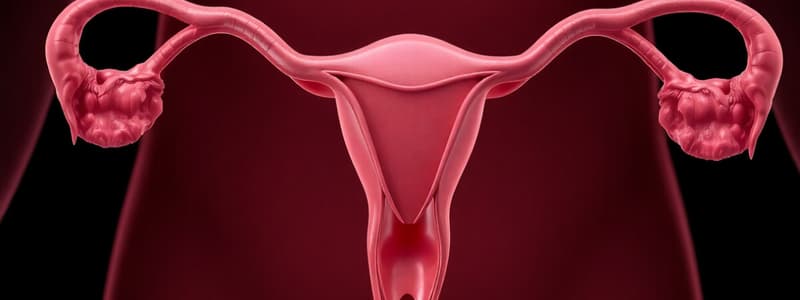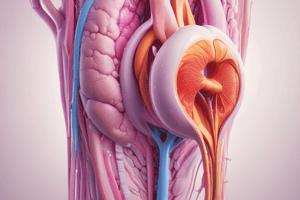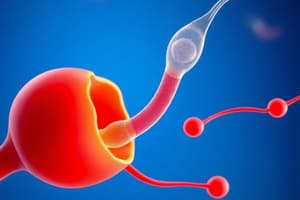Podcast
Questions and Answers
Which cells in the testes are primarily responsible for the production of testosterone?
Which cells in the testes are primarily responsible for the production of testosterone?
- Leydig cells (correct)
- Sertoli cells
- Myoid cells
- Spermatogonia
What hormone stimulates the Leydig cells to secrete testosterone?
What hormone stimulates the Leydig cells to secrete testosterone?
- Follicle-stimulating hormone (FSH)
- Luteinizing hormone (LH) (correct)
- Prolactin
- Gonadotropin-releasing hormone (GnRH)
Spermatogenesis occurs in which part of the male reproductive system?
Spermatogenesis occurs in which part of the male reproductive system?
- Vas deferens
- Prostate gland
- Seminiferous tubules (correct)
- Epididymis
Which hormone directly stimulates spermatogenesis by acting on the Sertoli cells?
Which hormone directly stimulates spermatogenesis by acting on the Sertoli cells?
What is the function of inhibin, secreted by Sertoli cells, in the male reproductive system?
What is the function of inhibin, secreted by Sertoli cells, in the male reproductive system?
Which of the following structures is the primary site of sperm maturation?
Which of the following structures is the primary site of sperm maturation?
Which enzyme is responsible for converting testosterone to dihydrotestosterone (DHT), the more potent form of testosterone?
Which enzyme is responsible for converting testosterone to dihydrotestosterone (DHT), the more potent form of testosterone?
What role does androgen-binding protein (ABP), produced by Sertoli cells, play in spermatogenesis?
What role does androgen-binding protein (ABP), produced by Sertoli cells, play in spermatogenesis?
What is the role of the blood-testis barrier formed by Sertoli cells?
What is the role of the blood-testis barrier formed by Sertoli cells?
During ejaculation, sperm are propelled from the epididymis into which structure?
During ejaculation, sperm are propelled from the epididymis into which structure?
Which hormone is primarily responsible for the release of follicle-stimulating hormone (FSH) and luteinizing hormone (LH) from the anterior pituitary?
Which hormone is primarily responsible for the release of follicle-stimulating hormone (FSH) and luteinizing hormone (LH) from the anterior pituitary?
In which part of the sperm cell does the acrosome reaction take place, which is vital for fertilization?
In which part of the sperm cell does the acrosome reaction take place, which is vital for fertilization?
Which gland produces a fluid that provides fructose, serving as an energy source for sperm?
Which gland produces a fluid that provides fructose, serving as an energy source for sperm?
What neurotransmitter is chiefly involved in causing vasodilation to initiate an erection of the penis?
What neurotransmitter is chiefly involved in causing vasodilation to initiate an erection of the penis?
Which anterior pituitary hormone indirectly supports spermatogenesis by maintaining the male reproductive tract?
Which anterior pituitary hormone indirectly supports spermatogenesis by maintaining the male reproductive tract?
Which hormone serves as a signal for initiating the process of spermatogenesis in males?
Which hormone serves as a signal for initiating the process of spermatogenesis in males?
The secretion of which substance by the seminal vesicles enhances sperm motility by providing energy?
The secretion of which substance by the seminal vesicles enhances sperm motility by providing energy?
Which of the following is NOT a function of nitric oxide in the male reproductive system?
Which of the following is NOT a function of nitric oxide in the male reproductive system?
What is the primary action of Gonadotropin-releasing hormone (GnRH) in the male reproductive system?
What is the primary action of Gonadotropin-releasing hormone (GnRH) in the male reproductive system?
Which component is primarily responsible for the energy supply during the movement of sperm toward the egg?
Which component is primarily responsible for the energy supply during the movement of sperm toward the egg?
Flashcards are hidden until you start studying
Study Notes
Male Reproductive System
- Leydig cells are responsible for producing testosterone in the testes.
- Luteinizing hormone (LH) stimulates Leydig cells to secrete testosterone.
- Spermatogenesis, the process of sperm production, occurs within the seminiferous tubules of the testes.
- Follicle-stimulating hormone (FSH) directly stimulates spermatogenesis by acting on Sertoli cells.
- Sertoli cells also produce inhibin, a hormone that inhibits the release of FSH, thus regulating spermatogenesis.
- Mature sperm cells are primarily stored and further matured within the epididymis.
- 5-alpha reductase is the enzyme responsible for converting testosterone to dihydrotestosterone (DHT).
- Androgen-binding protein (ABP) produced by Sertoli cells binds testosterone to maintain high local concentrations within the seminiferous tubules, supporting spermatogenesis.
- The blood-testis barrier, formed by Sertoli cells, safeguards developing sperm cells from the immune system.
- During ejaculation, sperm are propelled from the epididymis through the vas deferens.
- Gonadotropin-releasing hormone (GnRH), released from the hypothalamus, regulates the release of FSH and LH from the anterior pituitary.
- The acrosome, a cap-like structure on the head of the sperm cell, contains enzymes that aid in fertilization.
- The seminal vesicles contribute fructose, an energy source for sperm, to the seminal fluid.
- Nitric oxide plays a crucial role in penile erection by inducing vasodilation.
- Follicle-stimulating hormone (FSH) helps maintain the male reproductive tract by supporting spermatogenesis.
Studying That Suits You
Use AI to generate personalized quizzes and flashcards to suit your learning preferences.




